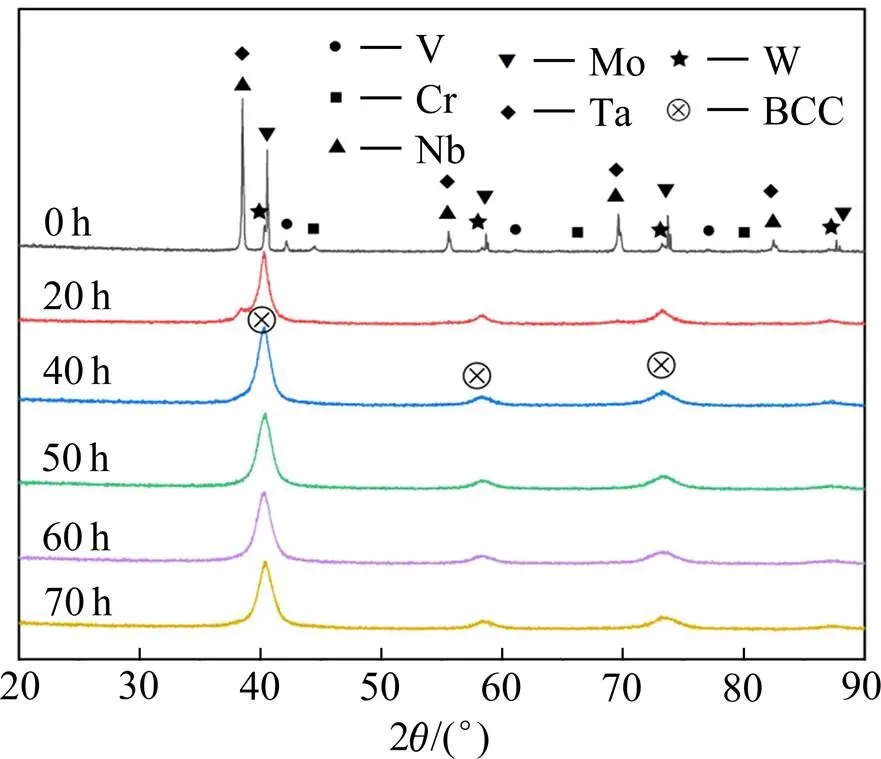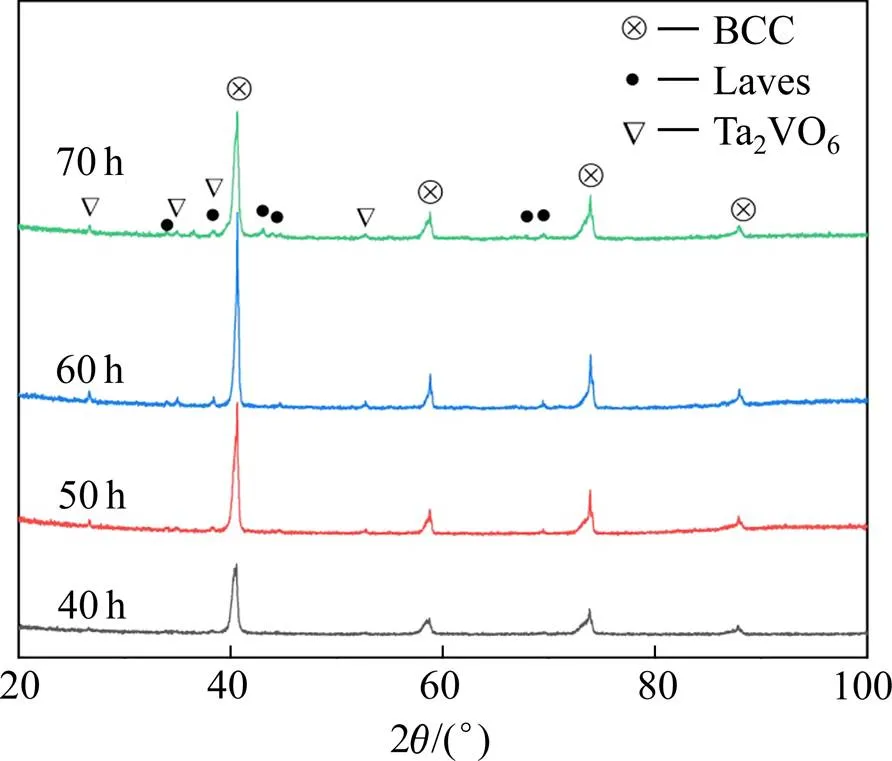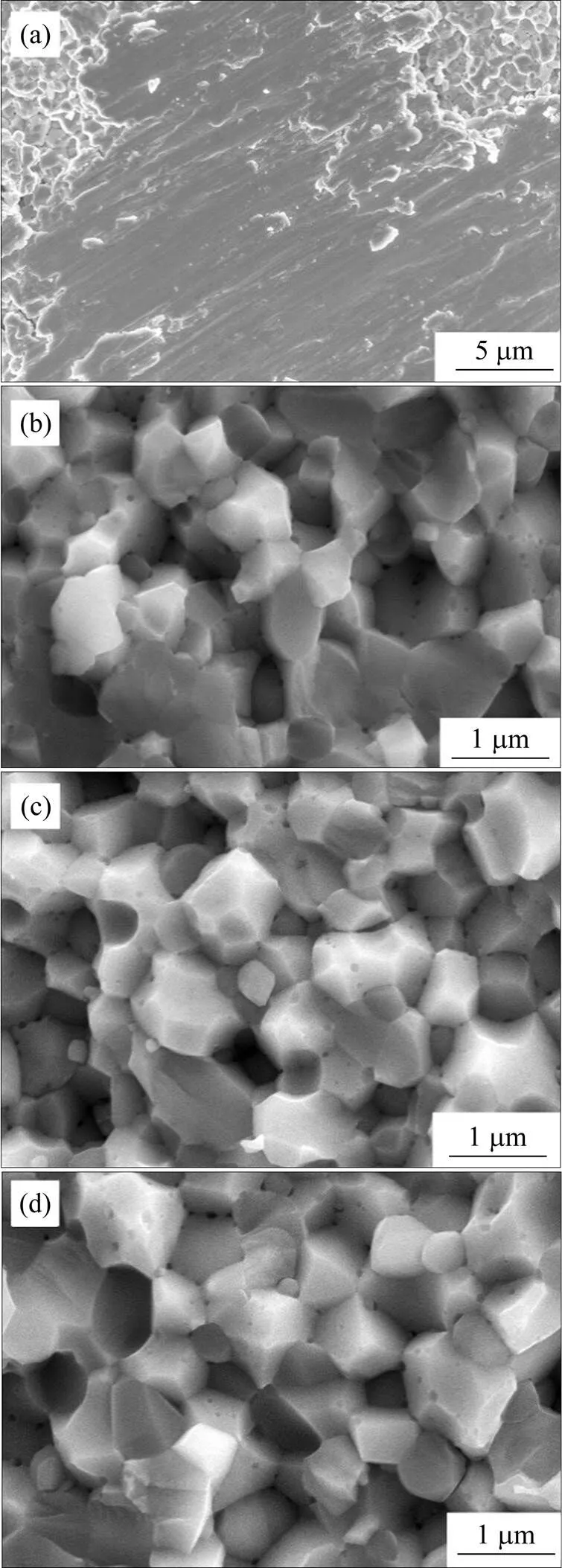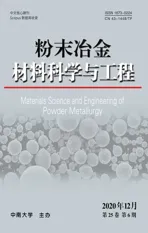球磨时间对NbMoTaWVCr难熔高熵合金组织与性能的影响
2021-01-13彭海燕康志新李小珍周莉龙雁
彭海燕,康志新,李小珍,周莉,龙雁
球磨时间对NbMoTaWVCr难熔高熵合金组织与性能的影响
彭海燕1, 2,康志新2, 3,李小珍2,周莉1,龙雁2, 3
(1. 广东技术师范大学 机电学院,广州 510635;2. 华南理工大学 广东省金属新材料制备与成形重点实验室,广州 510640;3. 华南理工大学 机械与汽车工程学院,广州 510640)
以Nb、Mo、Ta、W、V、Cr等金属粉末为原料,采用机械合金化与放电等离子烧结相结合的方法制备难熔NbMoTaWVCr高熵合金,研究球磨时间对合金的物相组成、显微组织与压缩性能的影响。结果表明,经过40 h球磨即可实现机械合金化,得到单相体心立方(BCC)结构的NbMoTaWVCr高熵合金粉末。随球磨时间延长,粉末的晶粒细化,微观应变增大。经1 500 ℃放电等离子烧结后的块体合金由BCC基体和Laves相以及氧化物相组成,析出相含量随球磨时间延长而增加。随球磨时间延长,NbMoTaWVCr难熔高熵合金的压缩屈服强度先增加后减小,塑性逐渐减小,在球磨40 h下的NbMoTaWVCr高熵合金块体材料具有最佳力学性能,压缩屈服强度和塑性应变分别为3 416 MPa和5.3%。
难熔高熵合金;机械合金化;放电等离子烧结;球磨时间;显微组织;屈服强度
随着航空航天和化学工业的发展,对材料的使用温度、高温强度和耐腐蚀性能等提出了更高的要求。高熵合金(high entropy alloy, HEA)又称为多主元合金,是由5种或者5种以上等原子比或接近等原子比的元素经合金化而合成的,其中每种元素的摩尔分数在5%~35%之间[1−4]。高熵合金具有比传统合金更优异的性能,如较高的强度、良好的耐磨、耐高温和耐腐蚀等性能等[5−11]。SENKOV等[12−14]研究了一系列高熔点的高熵合金,发现在高温下,具有BCC结构的NbMoTaWV合金具有比传统的超合金更好的力学性能,其他系列的难熔高熵合金如TaNbHfZrTi[14]、TiZrNbTaMo[15]和AlNbTiVZr[16]也得到研究和发展。目前制备高熵合金主要采用铸造法,但难熔高熵合金的熔点高,采用铸造法制备较困难,并且铸造法制备的合金一般存在枝晶偏析以及晶粒粗大等问题,影响材料的性能。SENKOV等[13]采用铸造法制备的NbMoTaWV难熔高熵合金,在室温和高温下都具有较高的屈服强度,特别是温度达到900 ℃时,屈服强度超过传统的镍基高温合金,表现出显著的抗高温软化能力,但室温下的塑性应变只有1.7%,合金的晶粒粗大(80 μm)。采用机械合金化(mechanical alloying, MA)与放电等离子烧结(spark plasma sintering, SPS)相结合的粉末冶金法制备难熔高熵合金可以消除成分偏析,并具有晶粒细小和组织均匀等优点[17−20];并且由于制备过程中无需将温度加热到合金的熔点以上,对设备要求相对较低。本文以Nb、Mo、Ta、W、V和Cr等金属粉末为原料,通过机械合金化与放电等离子烧结制备细晶NbMoTaWVCr高熵合金块体材料,着重研究球磨时间对合金显微组织和力学性能的影响。对于高性能NbMoTaWVCr难熔高熵合金的制备与应用具有重要意义。
1 实验
1.1 NbMoTaWVCr高熵合金的制备
实验采用纯度(质量分数)均大于99.9%的Nb、Mo、Ta、W、V、Cr等6种金属粉末,所有金属粉末均由中诺新材科技有限公司生产,粉末粒度均≤45 μm。按照等摩尔分数计算出各原料粉末的质量。称取原料粉末,装入洁净塑料瓶中,用V型混粉机混合均匀(混料时间为20 h)。将混合粉末置于球磨罐中进行高能球磨,磨球和球磨罐的材质均为不锈钢,磨球平均直径为10 mm,球料质量比为12:1。采用Ar气作为保护气氛,球磨时间分别为20、40、50、60和70 h。球磨后取出适量粉末进行分析和测试。将球磨40~70 h的粉末置于石墨模具中进行放电等离子烧结,所用设备为日本Sumitomo Coal Mining Co. Ltd.公司生产。烧结压力为30 MPa,在1 500 ℃保温10 min,然后随炉冷却至室温,得到直径为20 mm、高度为10 mm的圆柱形NbMoTaWVCr高熵合金样品。
1.2 组织与性能表征
采用X射线衍射仪(XRD,Bruke D8 ADVANCE X-ray diffractometer)和美国FEI公司的TECNAL G2 F20 S-TWIN 透射电镜(TEM)分析NbMoTaWVCr高熵合金粉末的显微组织与形貌。通过X射线衍射分析和扫描电镜(SEM,ZEISS merlin,德国),研究块体合金的显微组织。用线切割的方法从圆柱形块体合金上切取3个直径为3 mm、长度6 mm的试样,用万能试验机(AG-100 kNX,Schimadzu Corporation,Japan)进行压缩性能测试,应变速率为10−3/s。
2 结果与分析
2.1 NbMoTaWVCr合金粉末
图1所示为高能球磨不同时间后NbMoTaWVCr难熔高熵合金粉末的XRD谱。从图中看出,球磨前,混合粉末中的V、Cr、Nb、Mo、Ta、W等6种粉末的衍射峰清晰可见。球磨20 h后,Cr与V的衍射峰消失,其他元素的衍射峰强度急剧降低。球磨时间延长至40 h时,仅在原有的W和Mo衍射峰附近观察到新的衍射峰,为BCC相。元素的合金化顺序和元素的熔点有很大关系,一般情况下,熔点越高的元素,越难实现合金化[21]。图1所示结果表明球磨40 h时合金化过程已经完成,形成单相BCC结构的固溶体。从图1还看到,完成合金化后,继续延长球磨时间,衍射峰位置和强度变化不大,半高宽略有增大。衍射峰的半高宽增大主要是由晶粒细化和微观应变引起[22−23],所以球磨40 h时合金化过程已经完成,形成单相BCC固溶体;随球磨时间延长,NbMoTaWVCr晶粒细化,微观应变增加。根据XRD谱,采用Wlliamson-Hall公式计算合金粉末的平均晶粒尺寸和晶格畸变,结果列于表1。从表1看出,随球磨时间从40 h增加到70 h,合金的平均晶粒尺寸从9.7 nm减小至5.2 nm,微观应变从0.42%增加到0.55%。
图2所示为球磨40 h的NbMoTaWVCr高熵合金粉末的透射电镜明场像和选区衍射图。从图2(a)看出,合金粉末的平均晶粒尺寸为10 nm左右,与利用XRD谱计算的平均晶粒尺寸9.7 nm基本一致。图2(b)的选区衍射环为典型的BCC晶体结构,与XRD谱一致。

图1 不同球磨时间的NbMoTaWVCr高熵合金粉末XRD谱

表1 球磨时间对NbMoTaWVCr高熵合金粉末晶粒尺寸和微观应变的影响
2.2 NbMoTaWVCr块体高熵合金
2.2.1 物相组成
图3所示为块体NbMoTaWVCr高熵合金的XRD谱。由图可见,球磨40 h下的NbMoTaWVCr高熵合金中含有BCC相、四方结构的Ta2VO6相以及对应于Cr2Ta的Laves相。延长球磨时间对合金的物相种类没有影响,但Ta2VO6和Cr2Ta这2种析出相的衍射峰强度逐渐增强,表明合金中析出相的含量增加。根据图1可知,球磨后的NbMoTaWVCr高熵合金粉末为单相BCC固溶体粉末,但经过SPS后生成了新相,这意味着在烧结过程中从过饱和固溶体中析出氧化物相和Laves相。机械合金化是一种非平衡过程,可以促进亚稳态过饱和固溶体的形成,而在烧结过程中随温度升高,过饱和固溶体逐渐分解,析出新相。

图2 球磨40 h后的NbMoTaWVCr高熵合金粉末的TEM图
(a) Bright field image; (b) Corresponding SEAD pattern

图3 不同球磨时间下的块体NbMoTaWVCr高熵合金XRD谱
2.2.2 显微组织
图4所示为不同球磨时间下的NbMoTaWVCr高熵合金SEM背散射形貌。从图中看出,合金组织均由白色的BCC基体、晶界处的灰色Laves相及黑色的Ta2VO6氧化物组成。在图4中对3种不同颜色的区域进行EDS能谱分析,结果列于表2。可以看出白色基体中6种元素的含量较接近名义成分,故确定白色相为无序BCC基体相;灰色相中含较多的Cr、Nb、Ta和少量的V,几乎不含Mo和W,为Cr2Ta中固溶Nb和V所形成的复杂金属间化合物,该相对应于在XRD谱中的Laves相;而黑色相则为Ta2VO6氧化物相。从图4看出,随球磨时间延长,合金的晶粒尺寸逐渐减小,析出相含量逐渐增加。球磨时间为70 h的合金中,部分析出相开始在晶界聚集,并互相联接。这一方面是因为在机械合金化过程中,随球磨时间延长,晶粒明显细化,晶格畸变增加,粉末中位错、空位、亚晶界、层错等缺陷增加。在SPS升温过程中,晶体缺陷的存在可有效缩短原子间的扩散距离[24],并使得原子扩散速度增大,促进Laves相及氧化物相从过饱和固溶体中析出;另一方面,虽然在球磨前对磨罐内抽真空并充氩气保护,但仍残留少量空气,从而导致合金粉末中掺入少量的氧[22, 25]。随球磨时间延长,粉末中掺杂的氧增加,以原子态固溶在合金粉末中的氧在烧结过程中倾向于与Ta、V形成氧化物在晶界析出,有人采用粉末冶金法制备高熵合金时,也发现氧化物或者碳化物的存在[26−30]。因此,延长球磨时间会导致烧结过程中析出相增加。

图4 不同球磨时间下的NbMoTaWVCr高熵合金SEM背散射图
(a) 40 h; (b) 50 h; (c) 60 h; (d) 70 h

表2 NbMoTaWVCr高熵合金的名义成分和图4(a)中不同物相的成分
2.2.3 力学性能
图5所示为不同球磨时间下的NbMoTaWVCr高熵合金的压缩应力−应变曲线,屈服强度0.2和塑性应变p列于表3。表4所列为近年来国内外文献报道的难熔高熵合金性能。由图5、表3和表4可见,本研究的所有NbMoTaWVCr高熵合金的屈服强度都较高,均在3 400 MPa以上。球磨40 h下的NbMoTaWVCr高熵合金具有较好的综合力学性能,0.2和p分别为3 416 MPa和5.3%,相对于SENKOV等[3]采用铸造法制备的NbMoTaWV高熵合金[13](0.2和p分别为1 246 MPa和1.7%),该合金的0.2和p分别提高174.1%和211.8 %,并且在保持一定塑性的情况下,其屈服强度还明显优于其他一些文献报道的难熔高熵合金强度[31−34]。当球磨时间延长至50 h时,合金的强度有所增加,但塑性明显降低。球磨时间进一步延长时,材料早期发生脆性断裂,反而导致强度下降。从图4可知,随球磨时间延长,NbMoTaWVCr高熵合金晶界处的析出相显著增多,在变形过程中裂纹容易沿第二相粒子处扩展,加剧了第二相对基体的割裂作用,使得塑性应变降低。

图5 不同球磨时间下的NbMoTaWVCr高熵合金压缩应力−应变曲线

表3 球磨时间对NbMoTaWVCr高熵合金压缩性能的影响
图6所示为NbMoTaWVCr高熵合金的压缩断口形貌。由图可见,球磨40 h 下的合金有2种不同的断裂特征区域,即较粗糙的沿晶断裂区域和较平滑的穿晶断裂区域。在平滑断裂区还看到由于剪切断裂所留下的摩擦痕迹。随高能球磨时间延长,NbMoTaWVCr高熵合金的断裂面呈冰糖状形貌,具有典型的脆性断裂特征。

图6 不同球磨时间下的NbMoTaWVCr高熵合金压缩断口SEM形貌
(a) 40 h; (b) 50 h; (c) 60 h; (d) 70 h
3 结论
1) 对Nb、Mo、Ta、W、V、Cr等金属粉末进行混合高能球磨,球磨40 h即完成机械合金化,得到单相BCC结构的NbMoTaWVCr固溶体。随球磨时间从40 h延长至70 h,粉末的平均晶粒尺寸从9.7 nm减小至5.2 nm,微观应变由0.42%增加至0.55%。
2) NbMoTaWVCr高熵合金粉末在1 500 ℃放电等离子烧结后,所得块体合金由BCC基体相、少量的Laves相与Ta2VO6氧化物析出相组成。随球磨时间延长,析出相含量增加。
3) 随球磨时间延长,NbMoTaWVCr高熵合金的屈服强度先升高后减小,塑性逐渐减小。球磨40 h下的合金具有最佳力学性能,压缩屈服强度和塑性应变分别为3 416 MPa和5.3%。
[1] YEH J W, CHEN S K, LIN S J, et al. Nanostructured high- entropy alloys with multiple principal elements: Novel alloy design concepts and outcomes[J]. Advanced Engineering Materials, 2004, 6(5): 299−303.
[2] MIRACLE D B, SENKOV O N. A critical review of high entropy alloys and related concepts[J]. Acta Materialia, 2017, 122: 448−511.
[3] GAO M C, YEH J W, LIAW P K, et al. High-Entropy Alloys[M]. New York: Springer Science & Business Media, 2016.
[4] 王江, 黄维刚. CrMoVNbFe高熵合金微观组织结构与力学性能[J]. 材料研究学报, 2016, 30(8): 609−613. WANG Jiang, HUANG Weigang. Microstructure andproperties of CrMoVNbFehigh entropy alloys[J]. Chineses Journal of Materials Research, 2016, 30(8): 609−613.
[5] GLUDOVATZ B, HOHENWARTER A, CATOOR D, et al. A fracture-resistant high-entropy alloy for cryogenic applications [J]. Science, 2014, 345(6201): 1153−1158.
[6] CHOU Y L, YEH J W, SHIH H C. The effect of molybdenum on the corrosion behaviour of the high-entropy alloys Co1.5CrFeNi1.5Ti0.5Moin aqueous environments[J]. Corrosion Science, 2010, 52(8): 2571−2581.
[7] CHEN Y Y, DUVAL T, HUNG U D, et al. Microstructure and electrochemical properties of high entropy alloys—A comparison with type-304 stainless steel[J]. Corrosion Science, 2005, 47(9): 2257−2279.
[8] CHUANG M, TSAI M, WANG W, et al. Microstructure and wear behavior of AlCo1.5CrFeNi1.5Tihigh-entropy alloys[J]. Acta Materialia, 2011, 59(16): 6308−6317.
[9] GORR B, AZIM M, CHRIST H J, et al. Phase equilibria, microstructure, and high temperature oxidation resistance of novel refractory high-entropy alloys[J]. Journal of Alloys and Compounds, 2015, 624: 270−278.
[10] ZHANG Y, ZUO T T, TANG Z, et al. Microstructures and properties of high-entropy alloys[J]. Progress in Materials Science, 2014, 61: 1−93.
[11] YEH J W, CHEN S K, GAN J Y, et al. Formation of simple crystal structures in Cu-Co-Ni-Cr-Al-Fe-Ti-V alloys with multiprincipal metallic elements[J]. Metallurgical and Materials Transactions A, 2004, 35(8): 2533−2536.
[12] SENKOV O N, WILKS G B, MIRACLE D B, et al. Refractory high-entropy alloys[J]. Intermetallics, 2010, 18(9): 1758−1765.
[13] SENKOV O N, WILKS G B, SCOTT J M, et al. Mechanical properties of Nb25Mo25Ta25W25and V20Nb20Mo20Ta20W20refractory high entropy alloys[J]. Intermetallics, 2011, 19(5): 698−706.
[14] SENKOV O N, SCOTT J M, SENKOVA S V, et al. Microstructure and room temperature properties of a high-entropy TaNbHfZrTi alloy[J]. Journal of Alloys and Compounds, 2011, 509(20): 6043−6048.
[15] WANG S, XU J. TiZrNbTaMo high-entropy alloy designed for orthopedic implants: As-cast microstructure and mechanical properties[J]. Materials Science and Engineering C, 2017, 73: 80−89.
[16] YURCHENKO N Y, STEPANOV N D, ZHEREBTSOV S V, et al. Structure and mechanical properties of B2ordered refractory AlNbTiVZr(=0~1.5) high-entropy alloys[J]. Materials Science and Engineering A, 2017, 704: 82−90.
[17] CHEN W, FU Z, FANG S, et al. Alloying behavior, microstructure and mechanical properties in a FeNiCrCo0.3Al0.7high entropy alloy[J]. Materials & Design, 2013, 51: 854−860.
[18] FU Z, CHEN W, CHEN Z, et al. Influence of Ti addition and sintering method on microstructure and mechanical behavior of a medium-entropy Al0.6CoNiFe alloy[J]. Materials Science and Engineering A, 2014, 619: 137−145.
[19] WANG P, CAI H, ZHOU S, et al. Processing, microstructure and properties of Ni1.5CoCuFeCr0.5−xVhigh entropy alloys with carbon introduced from process control agent[J]. Journal of Alloys and Compounds, 2017, 695: 462−475.
[20] SATHIYAMOORTHI P, BASU J, KASHYAP S, et al. Thermal stability and grain boundary strengthening in ultrafine-grained CoCrFeNi high entropy alloy composite[J]. Materials & Design, 2017, 134: 426−433.
[21] CHEN Y, HU Y, HSIEH C, et al. Competition between elements during mechanical alloying in an octonary multi-principal- element alloy system[J]. Journal of Alloys and Compounds, 2009, 481(1/2): 768−775.
[22] SURYANARAYANA C. Mechanical alloying and milling[J]. Progress in Materials Science, 2001, 46(1/2): 1−184.
[23] WU B, CHEN W, JIANG Z, et al. Influence of Ti additionon microstructure and mechanical behavior of a FCC-based Fe30Ni30Co30Mn10 alloy[J]. Materials Science & Engineering A, 2016, 676: 492−500.
[24] 鲁世强, 黄伯云, 贺跃辉. 机械合金化对Laves相Cr2Nb固相热反应合成的影响[J]. 航空学报. 2003(6): 568−572. LU Shiqiang, HUANG Baiyun, HE Yuehui. The effect of mechanical alloying on synthesizing of Laves Cr2Nb by solid thermal reachion[J]. Acta Aeronautica & Astronautica Sinica, 2003(6): 568−572.
[25] MURTY B S, RANGANATHAN S. Novel materials synthesis by mechanical alloying/milling[J]. International Materials Reviews, 1998, 43(3): 101−141.
[26] PRAVEEN S, BASU J, KASHYAP S, et al. Exceptional resistance to grain growth in nanocrystalline CoCrFeNi high entropy alloy at high homologous temperatures[J]. Journal of Alloys and Compounds, 2016, 662: 361−367.
[27] PRAVEEN S, MURTY B S, KOTTADA R S. Phase evolution and densification behavior of nanocrystalline multicomponent high entropy alloys during sparkplasma sintering[J]. JOM, 2013, 65(12): 1797−1804.
[28] PRAVEEN S, MURTY B S, KOTTADA R S. Effect of molybdenum and niobium on the phase formation and hardness of nanocrystalline CoCrFeNi high entropy alloys[J]. Journal of Nanoscience and Nanotechnology, 2014, 14(10): 8106−8109.
[29] LONG Y, SU K, ZHANG J F, et al. Enhanced strength of a mechanical alloyed NbMoTaWVTi refractory high entropy alloy [J]. Materials, 2018, 11(5): 669−676.
[30] FU Z Q, HOFFMAN A, MACDONALD B E, et al. Atom probe tomography study of an Fe25Ni25Co25Ti15Al10 high-entropy alloy fabricated by powder metallurgy[J]. Acta Materialia, 2019, 179: 372−382.
[31] SENKOV O N, JENSEN J K, PILCHAK A L, et al. Compositional variation effects on the microstructure and properties of a refractory high-entropy superalloy AlMo0.5NbTa0.5TiZr[J]. Materials and Design, 2018, 139: 498− 511.
[32] GE S F, FU H M, ZHANG L, et al. Effects of Al addition on the microstructures and properties of MoNbTaTiV refractory high entropy alloy[J]. Materials Science & Engineering A, 2020, 784: 139−275.
[33] SENKOV O N, ZHANG C, PILCHAK A L, et al. CAPLHAD- aided development of quaternary multi-principal element refractory alloys based on NbTiZr[J]. Journal of Alloys and Compounds, 2019, 783: 729−742.
[34] SENKOV O N, ISHEIM D, SEIDMAND N, et al. Development of a refractory high entropy superalloy[J]. Entropy, 2016, 18(102): 1−13.
[35] LIU Y, ZHANG Y, ZHANG H, et al. Microstructures and mechanical properties of refractory HfMo0.5NbTiV0.5Sihigh- entropy composites[J]. Journal of Alloys and Compounds. 2017, 694: 869−876.
Effects of ball milling time on microstructure and properties of NbMoTaWVCr refractory high entropy alloy
PENG Haiyan1, 2, KANG Zhixin2, 3, LI Xiaozhen2, ZHOU Li1, LONG Yan2, 3
(1. School of Mechatronic Engineering, Guangdong Polytechnic Normal University, Guangzhou 510635, China; 2. Guangdong Key Laboratory for Advanced Metallic Materials, South China University of Technology, Guangzhou 510640, China; 3. School of Mechanical and Automotive Engineering, South China University of Technology, Guangzhou 510640, China)
Refractory NbMoTaWVCr high entropy alloy (HEA) was fabricated by combination of mechanically alloying (MA) and spark plasma sintering (SPS) using powders of Nb, Mo, Ta, W and V as raw materials. The effects of milling time on phase composition, microstructure evolution and mechanical properties were investigated. The results show that mechanical alloying can be achieved after 40 h ball milling, and the single-phase BCC NbMoTaWVCr high entropy alloy powder is obtained. With the increase of milling time, the grain size is refined and the micro strain increases.The bulk alloy sintered by SPS at 1 500 ℃ consists of BCC matrix, Laves phase and oxide phase. The content of precipitated phase increases with the increase of milling time. With the increase of milling time, the compressive yield strength increases first and then decreases and the plasticity decreases gradually. The NbMoTaWVCr refractory high entropy alloy sintered from powders milled for 40 h exhibits an excellent yield strength of 3416 MPa and plastic strain of 5.3%.
refractory high-entropy alloy; mechanical alloying; spark plasma sintering; milling time; microstructure; yield strength
TG146.4+1
A
1673-0224(2020)06-513-07
广东省金属新材料制备与成形重点实验室开放课题(GJ201606);广东省普通高校新材料制备成形及加工工程技术研究中心资助项目(2017GCZX003)
2020−09−30;
2020−10−26
龙雁,教授,博士。电话:020-87113851;E-mail: ylong1@scut.edu.cn
(编辑 汤金芝)
